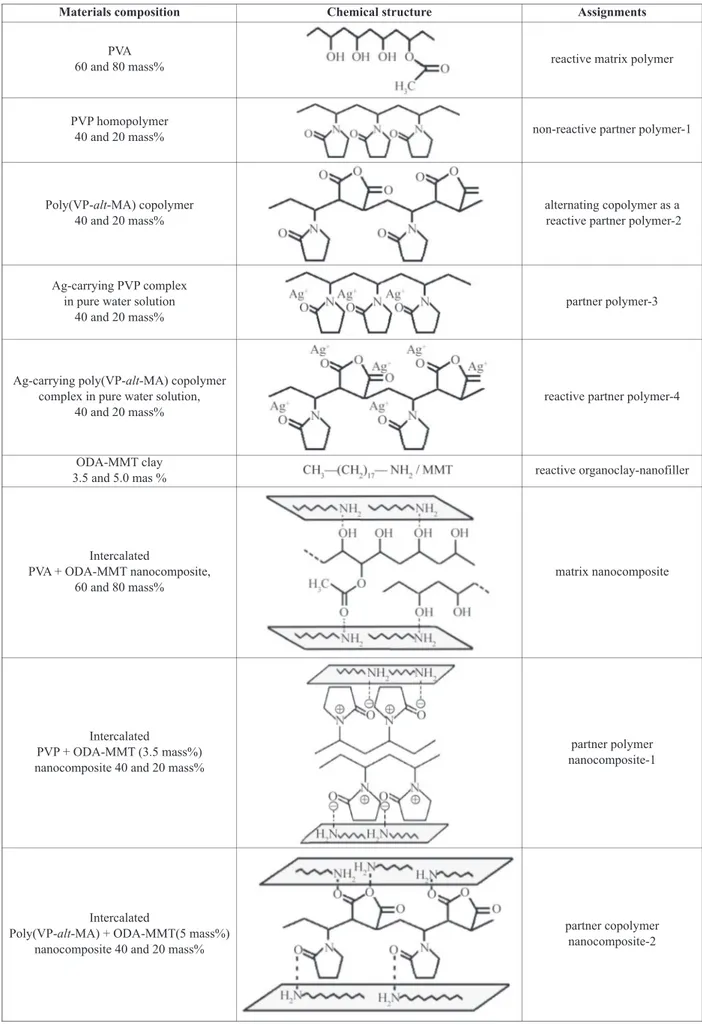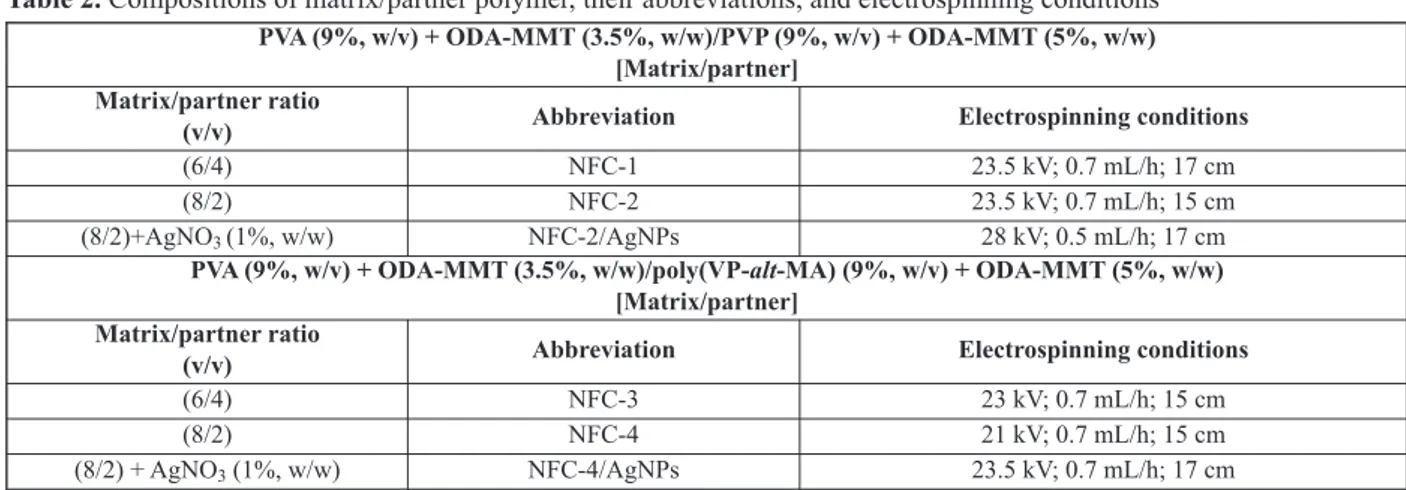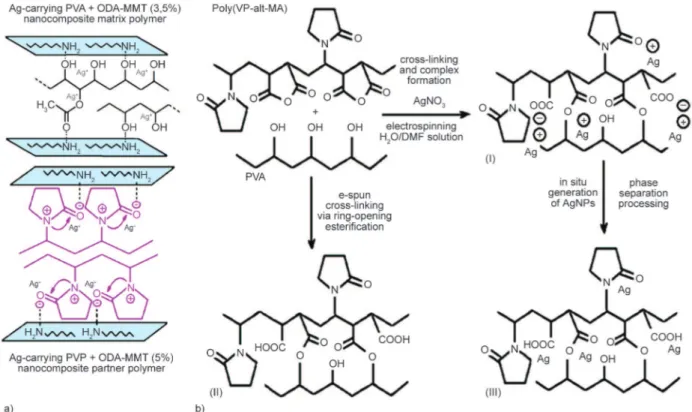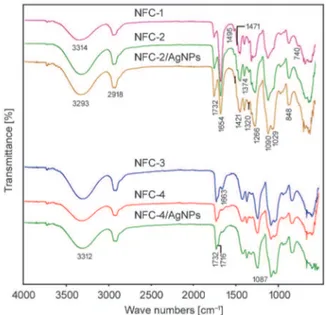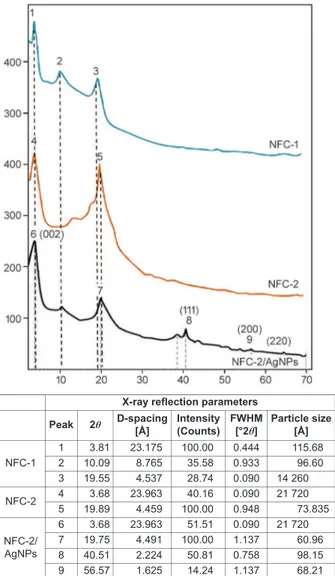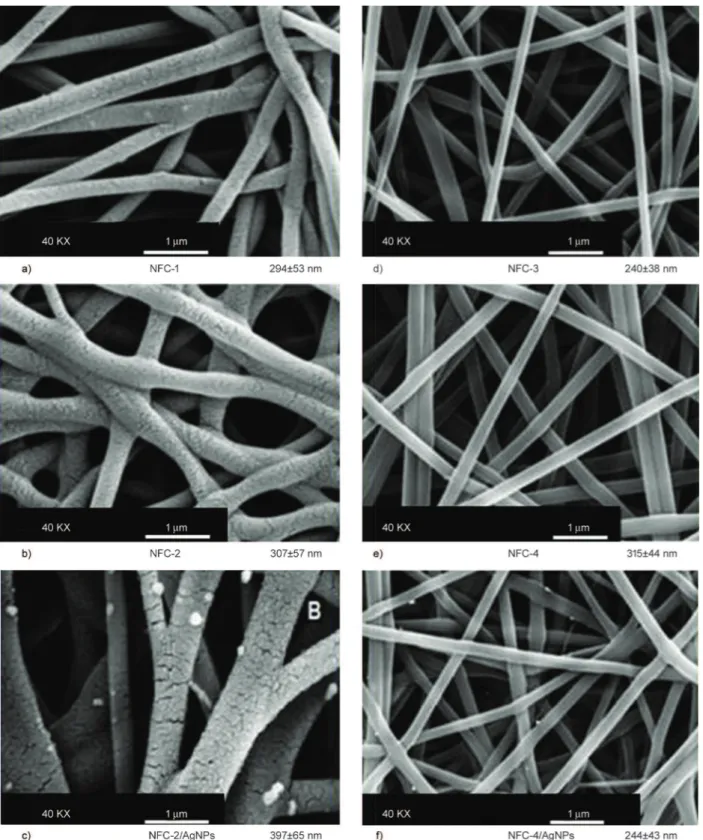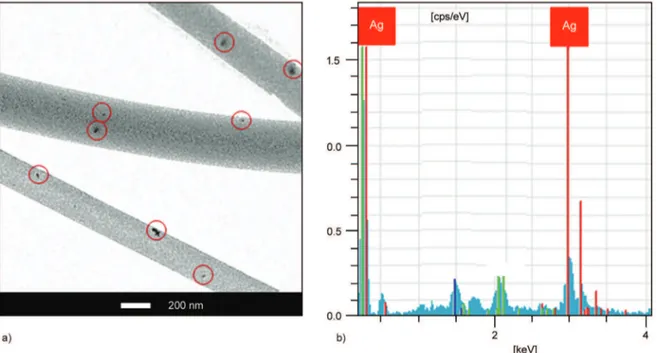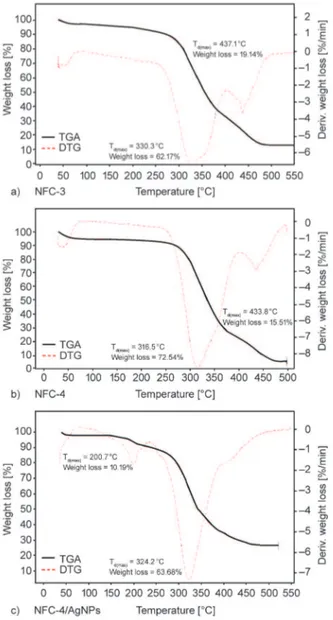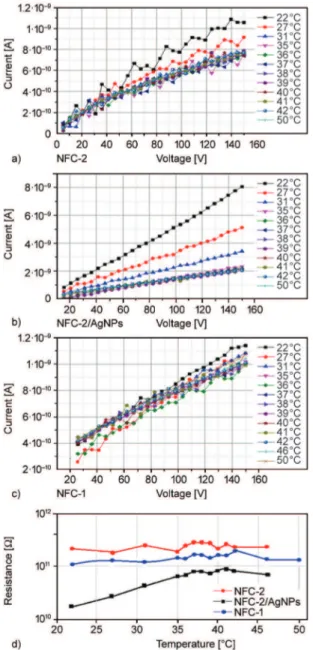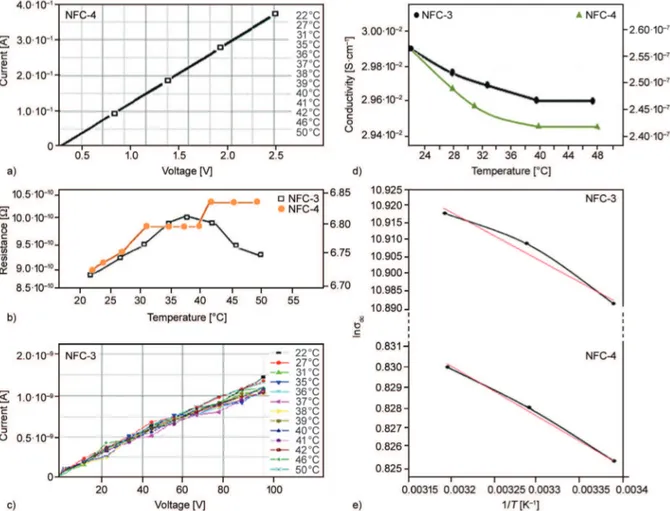1. Introduction
Recent studies have focused on the fabrication of electrospun (e-spun) nanofibers from solution blends of various polymers and/or polymer nanocompos-ites as binary multifunctional matrix/partner poly-mer systems [1–7]. Polypoly-mer nanofibers fabricated by electrospinning method have great importance be-cause of their unique properties, i.e. high surface area-to-volume ratio, nanoscale fiber diameter and nanoporous surface morphology [8, 9].
Water-soluble poly(vinyl alcohol) (PVA) has impor-tant chemical and physical properties such as film-and fiber forming, emulsifying, surfactant film-and adhe-sion. PVA containing intra- and internal hydrogen bonding hydroxyl groups easily forms network and branched structures when it reacts with other func-tional polymers and compounds. It is also used to fabricate unique nanofiber compositions as a matrix polymer [10, 11]. Some properties of polymers such as thermal, mechanical, and optical properties are
Multifunctional e-spun colloidal nanofiber structures from
various dispersed blends of PVA/ODA-MMT with
PVP/ODA-MMT, poly(VP-alt-MA) and AgNPs incorporated
polymer complexes as electro-active platforms
U. Bunyatova
1, Z. M. O. Rzayev
2*, M. Şimşek
21Department of Biomedical Engineering, Faculty of Engineering, Baskent University, Baglica, 06810 Ankara, Turkey 2Institute of Science and Engineering, Division of Nanotechnology and Nanomedicine, Hacettepe University,
06800 Ankara, Turkey
Received 6 November 2015; accepted in revised form 23 February 2016
Abstract. This work presented a new approach to fabricate polymer nanocomposites films with nanofiber structures from
solution blends of poly(vinyl alcohol) + octadecyl amine-montmorillonite (ODA-MMT) (matrix) with poly(N-vinylpyrroli-done) + ODA-MMT (partner-1), poly(N-vinylpyrrolidone-alt-maleic anhydride) ((poly(VP-alt-MA)) + (ODA-MMT) (partner-2) and their silver (Ag)-carrying polymer complexes by electrospinning. Chemical and physical structures, surface morphologies, thermal behaviors, electrical conductivity and thermal resistance parameters of nanofiber structures were in-vestigated. Poly(VP-alt-MA) was used both as a crosslinker and a donor of the hydrophilic groups such as ‒COOH and ‒NH–C=O amide from pyrrolidone ring. Reactive poly(VP-alt-MA), in situ generated Ag nanoparticles (AgNPs) and orig-inal partner polymer had an significant effect on the morphology and diameter distribution of nanofibers. High and excel-lent conductive behaviors were observed for the homopolymer and copolymer of VP based fiber structures, respectively. Upon successive chemical cross-linking of the nanofiber structures by reactive partner copolymer, the conductivity of nanofiber films as electro-active platforms dramatically increased to 3.90·10–2S·cm–1at room temperature. Comparative
analysis results also indicated that electrical properties strongly depended on the loaded reactive organoclay and in situ gen-erated AgNPs.
Keywords: polymer composites, PVA, PVP, electrospinning, conductivity. DOI: 10.3144/expresspolymlett.2016.55
*Corresponding author, e-mail:rzayevzmo@gmail.com
significantly improved by adding an organoclay into a polymeric matrix [12, 13].
Due to their unique properties, homo- and co- poly-mers of N-vinyl-2-pyrrolidone (VP) have attracted considerable academic and industrial interest [14, 15]. Poly(N-vinylpyrrolidone) (PVP) receives spe-cial attention among the conjugated polymers due to its good environmental stability, easy process-ability and moderate electrical conductivity. The re-active pyrrolidone group of PVP easily forms com-plexes with many inorganic salts, synthetic or natural functional polymers, biomolecules and biomacro-molecules. To synthesize alternating copolymers of VP with maleic anhydride (MA), the solution homo-geneous or heterohomo-geneous radical copolymerization is usually used by using various solvents such as ben-zene, toluene [16], and 1.4dioxane [17]. In our previ-ous study [18], poly(N-vinylpyrrolidone-alt-maleic anhydride) (poly(VP-alt-MA)) was easily dissolved in water. This dissolution process was accompanied by the full hydrolysis of anhydride units and given rise to the formation of strong hydrogen bonding in-termolecular fragments.
Conductivity and thermal resistance properties of solid polymer electrolytes can be improved with chemical cross-linking, grafting, graft copolymer-ization, functionalization of the polymer backbone and side-chains, polymer-polymer interactions and blending with other polymers and doping agents. PVA and PVP-based solid polymer electrolytes are potential materials exhibiting good charge storage capacity and dopant dependent electrical and optical properties. The conductivity of neat PVA nano -fibers was reported to be 1.25·10–15S·cm–1[19]
com-pared with that of PVP (7.42·10–8S·cm–1) [20]. Hatta
et al. [21] observed that solvent casting PVA/PVP thin-film solid electrolytes with a composition of 80% of PVA and 20% of PVP (v/v) exhibited the highest conductivity (2.2·10–7S·cm–1). The
con-ductivity of this system enhanced to 1.5·10–4S·cm–1
when KOH (40%) was added. According to Inzelt et al. [22] conductivity of functional polymer sys-tems depend on degree of chemical charges (such as dimerization, cross-linking, and ion-pair formation) and structural properties of chosen polymer systems, i.e. chain-segmental motions, changes in surface mor-phology and slow relaxation. In a study, Rajeswari et al. [23] prepared solvent casting polymer blend electrolytes with different concentrations of PVA and PVP. Maximum conductivity was found
1.58·10–6S·cm–1at room temperature for 70PVA:
30PVP (v/v) ratio without any doping agents. The authors also found that the conductivity increased to 5.49·10–5S·cm–1with increasing medium
temper-ature to 100 °C.
Besides their electrical conductivities, ionic conduc-tivity of polymer electrolytes is fundamentally due to the covalent bonding between the polymer back-bones with the ionizing groups. The electron donor group in the polymer generates dissolution to the cation constituent in dopant salt and then facilitates ion separation, causing ionic hopping mechanism. Thus, it generates the ionic conductivity. Novel ionic conductive e-spun PVA-chitosan nanofiber mem-branes were successfully fabricated using ionic liq-uids by Datta et al. [24]. Laforgue et al. [25] investi-gated ionic conductivity of PVA and Nafion-poly (ethylene oxide). nanofibers and found that Nafion-PVA mats were found to be more conduc-tive than the Nafion-PEO ones. Ionic conductivities of different polymer systems were also investigated by many researches [26–28].
Recently, many efforts have focused on the design and fabrication of polymer/metal nanoparticle (like silver) complexes due to their remarkable electronic, magnetic, catalytic, thermal and optical properties [29]. Basic principle for the fabrication of silver nanoparticles (AgNPs) involves the reduction of metal salts like silver nitrate (AgNO3) in an
appro-priate medium using various reducing agents and sur-factants to produce colloidal suspensions integrated by nanoparticles [29–32]. Unlike elemental silver, sil-ver salts easily dissolve in water, and they increase the rate of Ag+ion formation over that from
elemen-tal silver. Hong et al. [33] prepared PVA nanofibers by electrospinning of PVA/AgNO3(1%, w/w)
aque-ous solutions, followed by short heat treatment. Nguyen et al. [34] successfully synthesized PVA nanofibers containing AgNPs (2% w/w) through a combination of microwave irradiation and electro-spinning. Several studies showed that electrical and ionic conductivity of polymer electrolytes improved in the presence of silver salts [35–38]. PVP has also attracted a great deal of attention as a polymer that can stabilize in situ generated Ag nanoparticles [39, 40]. In situ formation of Ag-nanoparticles during electrospinning process of polymer-layered silicate nanocomposites and the formation of cross-linking fiber structures as colloidal electrolytes via phase separation processing have been scarcely
investi-gated in the presence of reactive alternating copoly-mer of VP.
One goal of this work was to develop synthetic path-ways for the fabrication of novel polymeric fiber-based electro-active nanostructures with unique self-assembled electron transfer sites via electrospinning nanotechnology. PVA, PVP and poly(VP-alt-MA) based multifunctional matrix/partner polymer sys-tems incorporated with an organoclay and AgNPs were fabricated and characterized. Another aim of this work was to evaluate effects of structural factors, origin and fraction of partner polymers, organoclay and in situ generated AgNPs on surface morpholo-gy and conductivity properties of nanofiber films. This work described physical and covalent function-alisation of octadecyl amine intercalated MMT clay via complexing with functional polymers (PVA, PVP) and AgNPs, and chemical cross-linking and amidization reactions of poly(VP-alt-MA) as reac-tive copolymer with octadecyl amine. All these in situ interactions occurred in the silicate layered region. Intercalated octadecyl amine as reactive surfactant and effective compatibilizer and reactive copolymer with alternating structures played important role in the functionalization of nanofiber composites (NFCs) before (dispersing solutions) and during electro-spinning process to fabricate NFCs as electro-active nanofiber platforms. The developed approach may open up new possibilities to fabricate novel electri-cally conductive nanomaterials and devices for var-ious engineering, electronic and nanotechnology applications.
2. Experimental
2.1. Materials
PVA (87–89% hydrolyzed, weight average molecu-lar weight (Mw= 31 000–51 000 g/mol),
poly(N-2-vinylpyrrolidone) (Bioshop-PVP504, high purity grade, average Mw= 40 000 Da), ODA-MMT
(con-tent of ODA surfactant-intercalant 25–30%, particle size of 8–10 µm, bulk density of 0.41 g/cm3 and
crystallinity of 52.8% (by, X-ray Diffraction), and silver nitrate (AgNO3, 99.995%, m.p. 202 °C with
decomposition, (density) d = 4.35 g/cm3) were
pur-chased from Sigma-Aldrich (Germany). N-vinyl-2-pyrrolidone (VP, Fluka, Germany) was purified by distillation under moderate vacuum. Maleic anhy-dride (MA, Aldrich, Germany) was purified by re-crystallization from anhydrous benzene solution and sublimation in vacuum. Azobisisobutyronitrile
(AIBN, Fluka, Germany) as a radical initiator was recrystallized twice from methanol. All other solvents and reagents were analytical grade and used without purification. Chemical structures, compositions and assignments of the materials used in electrospin-ning are given in Table 1.
2.2. Synthetic procedures
Alternating partner copolymer of VP with MA (poly(VP-alt-MA) was prepared by radical-initiat-ed copolymerization in the presence of AIBN as an initiator. The copolymerization was carried out in 1,4-dioxane solution into glass tube type micro re-actor by using molar (1:1) monomer mixture under nitrogen flow at 65 °C. The copolymer was isolated from the resultant mixture, purified by twice precip-itation in the presence of 1.4-dioxane solution with diethyl ether, and washed with benzene. After the last extraction by diethyl ether, the copolymer was isolated via centrifugation and dried at 40 °C under moderate vacuum to arrive constant weight. Syn-thesized poly(VP-alt-MA) had the following aver-age characteristics: acid number of 460 mg KOH/g (by alkaline titration); nitrogen content of N = 7.15 mass% (by elemental analysis); molar monomer unit ratio of m1(VP)/m2(MA) = 1.12 (m1 and m2
are relative amounts of VP and MA (in mol) in the copolymer, respectively); intrinsic viscosity of [ƞ]in=
0.79 dL/g in deionized water at 25 °C; glass transi-tion temperature of Tg= 159,8 °C (by DSC); and 1H-NMR spectra (in CHCl
3-d1), δ (ppm): 1.30–1.83
CH2(backbone), 3.56–3.95 CH (CH–N backbone),
1.83–2.33 CH2 and 2.95–3.54 2CH2 (pyrrolidone
ring) for VP unit and 4.08–4.45 CH (backbone) for anhydride unit.
PVA + ODA-MMT (3,5 mass%) nanocomposite as a matrix polymer was prepared by dispersed solution intercalating of PVA polymer chains between organ-oclay galleries in pure water medium under inten-sive mixing up to the formation of dispersed homo-geneous viscous product at 40 °C for 3 h. Water solutions of PVP (homopolymer) + ODA-MMT (5 mass%) and alternating copolymer poly(VP-alt-MA) + ODA-MMT (5 mass%) as an intercalated partner nanocomposite were prepared by using a similar procedure. Matrix/partner polymer/AgNO3
complexes were prepared by the addition of powder AgNO3(1 mass%) to the corresponding polymer
so-lution and each complex was additionally mixed at room temperature for 1 h.
Table 1. Chemical structures, compositions and assignments of the materials used in electrospinning
Materials composition Chemical structure Assignments
PVA
60 and 80 mass% reactive matrix polymer
PVP homopolymer
40 and 20 mass% non-reactive partner polymer-1
Poly(VP-alt-MA) copolymer 40 and 20 mass%
alternating copolymer as a reactive partner polymer-2
Ag-carrying PVP complex in pure water solution
40 and 20 mass%
partner polymer-3
Ag-carrying poly(VP-alt-MA) copolymer complex in pure water solution,
40 and 20 mass%
reactive partner polymer-4
ODA-MMT clay
3.5 and 5.0 mas % reactive organoclay-nanofiller
Intercalated
PVA + ODA-MMT nanocomposite, 60 and 80 mass%
matrix nanocomposite
Intercalated
PVP + ODA-MMT (3.5 mass%) nanocomposite 40 and 20 mass%
partner polymer nanocomposite-1
Intercalated
Poly(VP-alt-MA) + ODA-MMT(5 mass%) nanocomposite 40 and 20 mass%
partner copolymer nanocomposite-2
2.3. Fabrication of nanofiber electrolytes Solution blends of matrix/partner polymer compos-ites with various volume ratios in the presence and absence of silver precursor were used to fabricate polymer electrolytes with nanofiber structures by electrospinning method. Electrospinning parame-ters such as polymer concentration, applied voltage, tip-to-collector distance, and flow rate were opti-mized for each series of nanofiber composites. Ran-domly oriented nanofibers were obtained by col-lecting fibers onto an aluminum foil fixed on sta-tionary collector. First series of e-spun nanofibers was fabricated from PVA + ODA-MMT/PVP + ODA-MMT as a matrix/partner polymer composite system and its Ag-carrying composition. For sec-ond series of nanofibers, poly(VP-alt-MA) copoly-mer + ODA-MMT as a partner polycopoly-mer was used. Table 2 presents the composition of matrix/partner polymers, their abbreviations, and optimized elec-trospinning conditions.
Characterization and methods
The Fourier transfer infrared (FT-IR) spectra were recorded on a FT-IR Nicolet 510 spectrometer in the range of 4000–400 cm–1with a resolution of 4 cm–1.
XRD tests were performed with a PANANALYTI-CAL X-ray diffractometer equipped with a CuKα
tube and Ni filter (λ = 1.5406 Å). The XRD diffrac-tograms were measured at the angle of reflection in the range 1–70°. XRD data were analyzed using the DIFFRAC-Plus EVA and High Score Plus (particle size) programs, and the patterns were identified using the ICDD PDFMaint computer reference database.
Surface morphology of nanofibers was examined by using a Field Emission Scanning Electron
Micro-scope (FESEM, ZEISS SUPRA 40). All specimens were freeze-dried and coated with a thin layer of platinum before testing. Average diameters of fibers were calculated from SEM images of minimum a hundred individual fibers by using ImageJ software (NIH, Bethesda, MD) for each sample. The formation of AgNPs in fibers was visualized by a high con-trast transmission electron microscope (CTEM, FEI Tecnai G2 Spirit BioTwin). Energy-dispersive X-ray spectroscopy (EDX) analysis was used to investi-gate the formation of AgNPs on fiber surfaces. Thermo gravimetric (TGA) and differential scan-ning calorimetric (DSC) analyses were performed by using EXTRAR600 TG-DTA6300 and Diamond DSC Perkin Elmer Thermal Analyzers at a linear heating rate of 10 °C/min under nitrogen flow. Sam-ples were measured in a sealed alumina pan with a mass of about 10 mg. The thermal degradation tem-perature taking into account was the temtem-perature at onset (Tonset) and the temperature at maximum
weight loss (Td (max)).
Electrical conductivity and thermal resistance of nanofiber samples as solid/colloidal electrolytes were measured by using a test chamber (JANIS VPF 100 cryostat). Current through thin fiber film was recorded with a Keithley 2400 current-voltage meas-urement system. Square-shaped samples (0.25 cm2)
with four contact points at the corners were pre-pared to carry out conductivity measurements which were done according to the van der Pauw method. Experiments were conducted in temperature range of 20–50 °C with 1 °C steps (Keithley 6487 Picoam-meter/Voltage source) and pressure range of 50– 800 Torr (6.67 to 106.7 kPa). Sample temperature was monitored regularly by using a Pt 100 sensor close to the sample and measured with Lakeshore
Table 2. Compositions of matrix/partner polymer, their abbreviations, and electrospinning conditions PVA (9%, w/v) + ODA-MMT (3.5%, w/w)/PVP (9%, w/v) + ODA-MMT (5%, w/w)
[Matrix/partner] Matrix/partner ratio
(v/v) Abbreviation Electrospinning conditions
(6/4) NFC-1 23.5 kV; 0.7 mL/h; 17 cm
(8/2) NFC-2 23.5 kV; 0.7 mL/h; 15 cm
(8/2)+AgNO3 (1%, w/w) NFC-2/AgNPs 28 kV; 0.5 mL/h; 17 cm PVA (9%, w/v) + ODA-MMT (3.5%, w/w)/poly(VP-alt-MA) (9%, w/v) + ODA-MMT (5%, w/w)
[Matrix/partner] Matrix/partner ratio
(v/v) Abbreviation Electrospinning conditions
(6/4) NFC-3 23 kV; 0.7 mL/h; 15 cm
(8/2) NFC-4 21 kV; 0.7 mL/h; 15 cm
model 331-temperature controller with sensitivity of ±0.1 °C. All measurements were performed with a PC through a GPIB converter card.
3. Results and discussion
3.1. Synthetic pathways
The matrix nanocomposite was fabricated by inter-calating of PVA between ODA-MMT organoclay tetragonal 1:2 layers through –OH…NH2– complex
formation of hydroxyl groups of PVA with primary amine groups of octadecylamine surfactant-inter-calant. First intercalated partner nanocomposite (PVP + ODA-MMT) was prepared through physi-cal interaction (–C=O…NH2– complex-formation)
of carbonyl/amine groups of PVP (pyrrolidone unit) and ODA-MMT (amine), respectively. Second part-ner copolymer nanocomposite, poly(VP-alt-MA) + ODA-MMT, was synthesized under similar interca-lating conditions. In order to obtain Ag-carrying matrix/partner nanocomposite complex, certain amount of AgNO3 was added to solution of
ma-trix/partners nanocomposite and the resultant mix-ture was additionally mixed for 1 hour. To fabricate e-spun nanofibers, various solution blends of ma-trix/partner polymer nanocomposites at different ra-tios (10/0, 8/2 and 6/4 v/v) were used.
Synthetic pathways of nanocomposite nanofibers and chemistry of polymer-polymer covalent crosslink-ing are schematically represented in Figure 1. Mix-ing of matrix and partner polymer nanocomposite solutions in water and then the fabrication of nano -fibers from different solution blends by electrospin-ning was accompanied by various interfacial inter-actions between functional groups of both polymer nanocomposites and organoclay, most likely via hy-droxyl-amine, hydroxyl-amide, carbonyl-hydroxyl and carbonyl-amine hydrogen bonding, as well as sil-ver cation-electrondonor functional groups. In the presence of homopolymer in PVP + ODA-MMT nanocomposite as a partner polymer, in situ physical interfacial interactions between functional groups of matrix (–OH and –C=O ester) and partner (–NH–C=O amide from pyrrolidone ring) polymers, organic oc-tadecyl amine fractions, and ionized species from MMT clay were predominantly realized.
Number of physical interactions increased in the presence of poly(VP-alt-MA) + ODA-MMT as a partner copolymer due to additional presence of reac-tive anhydride –C=O and carboxyl –COOH groups. Moreover, these reactive groups provided effective grafting (amidization of anhydride unit with octade-cyl amine) and covalent cross-linking (esterification
Figure 1. a) The synthetic pathways to fabricate nanocomposites and nanofibers, b) chemistry of covalent cross-linking
ma-trix and partner polymer chains via ring-opening esterification: (I) Ag-carrying polymer complex, (II) cross-linked structure and (III) in situ generated AgNPs onto polymer chains
of anhydride unit with hydroxyl group of matrix polymer) between matrix-partner polymer chains. The observed covalent in situ interactions were im-portant structural factors to enhance the stable ion charged sites. Therefore the electrical conductivity of nanofiber structures significantly increased. Polymer-polymer, polymer-organoclay and polymer-silver forces altered the hydrophilic/hydrophobic balance and controlled the phase separation process, result-ing in the formation of fiber webs with unique dis-tributed cross-section fibrous morphology. Further-more, the phase separation process also accelerated significantly with the addition of silver ions through the formation of stable complexes with anion active functional groups as ion transfer sites onto matrix-partner polymer chains. It was demonstrated that the fabricated multifunctional electrolytes incorpo-rated with organoclay and AgNPs exhibited unique dispersed silver nanoparticles onto fiber surface. Silver cations turned into in situ generated AgNPs without the use of dominated annealing and UV-ir-radiation procedures throughout phase separation processing during electrospinning. This observation can be described as a simple and effective method to prepare AgNPs during electrospinning processing. 3.2. Chemical structures of nanofiber
composites
Figure 2 shows the IR spectra of the fabricated poly-mer nanofiber electrolytes. Broad absorption bands around 3314–3293 cm–1in spectra of all fiber
com-positions were associated with hydrogen-bonded OH and NH2 stretching from PVA and octadecyl
amine chains. Visible shift of this peak to the lower frequency region (NFC-2/AgNPs) can be explained by the increase of hydrogen bonding and complex-formation with AgNPs. Weak C–O–H band appeared around 1320 cm–1. These observations successfully
confirmed the formation of cross-linking structure via ring-opening inter-macromolecular esterifica-tion of maleic anhydride/carboxyl groups with hy-droxyl groups of matrix PVA chains during electro-spinning. Pyrrolidone unit (secondary amide) of partner PVP polymer was characterized with the following bands: C=O stretching around 1732 cm–1
for amide-I band, NH stretching around 1654 cm–1
for amide-II band, and C‒N stretching between 1421–1426 cm–1for amide-III band. NH
2
deforma-tion and wagging bands between 848–855 cm–1and
at 1495 cm–1 can be attributed to octadecyl amine
complex from ODA-MMT clay, and peak around 740 cm–1can be related to –CH
2– rocking band in
an octadecyl chain. C–H stretching bands around 2918 cm–1were related to CH, CH
2and CH3groups
from octadecyl group and backbone chains, and their bending bands appeared at 1471 and 1374 cm–1.
Characteristic broad peaks between 1255–1272 cm–1
and around 1090 cm–1were due to C–O and C–O–C
absorption bands from carboxyl and ester carboxy-late groups, respectively. Silicate band appeared at 1029 cm–1 (Si–O–Si). The following absorption
bands were observed in FTIR spectra of nanofiber composites containing poly(VP-alt-MA)+ODA-MMT: Absence of characteristic absorption bands from anhydride units of copolymer (1776 and 1840 cm–1) [41] in the carbonyl region of the
nanofiber’s spectra and appearance of C=O and C– O–C bands from ester groups (1732 and 1087 cm– 1), and maleate ‒COOH (1716 and 1663 cm–1 for
C=O and 3312 cm–1 for hydrogen bonded OH in
carboxyl group) were observed.
3.3. Physical structures of nanofiber composites
Physical structures of nanofibers were determined by XRD method. Obtained XRD patterns and peak reflection parameters are given in Figure 3. The
Figure 2. FT-IR spectra of NFC-1, NFC-2, and NFC-2/
AgNPs nanofibers from PVA + ODA-MMT/PVP + ODA-MMT; and NFC-3, NFC-4, and NFC-4/ AgNPs nanofibers from PVA + ODA-MMT/poly (VP-alt-MA) + ODA-MMT
well-known Scherrer equation (Equation (1)) was used to calculate particle sizes (τsh, the mean
thick-ness) in fiber structures [42]:
(1) where τ is the mean size of the ordered (crystalline) domains, which may be smaller or equal to the grain size; K is a Scherrer constant (Kshof 0.89); λ
is the X-ray wavelength (λ = 1.5406 nm); β is the line broadening at half the maximum intensity (FWHM), after subtracting the instrumental line broadening, in radians. The Bragg equation (Equation (2)) was used to calculate the interlayer spacing (d):
(2) where n is the order of reflection and 2θ is the angle of reflection.
The figure shows polymer composites exhibited semicrystalline structure since they contain crys-talline and amorphous structure. Cryscrys-talline peaks around 20° 2θ angle belonged to PVA, corresponding to (110) reflection. The intensity of the XRD patterns decreased since the amorphous nature of PVA in-creased with the addition of PVP. The increase in the amorphous nature of polymer electrolytes causes a re-duction in the energy barrier to the segmental motion of the polymer electrolyte resulting in high ionic conductivity [23].
Pristine ODA/MMT clay exhibits a strong peak at 2θ = 4.45° with a distance (d-spacing) of 19.93 Å (002) between two tetragonal layers and several crystallite peaks related to the intermolecular interac-tions of octadecyl amine and hydroxyl groups from the clay structure via ‒Si–OH…NH2‒ hydrogen
bonding at edges [43]. The position of reflection peak at 4.45° 2θ shifted to lower region (3.81 and 3.68° 2θ) with an increase in d-spacing from 19.93 Å (002) to 23.17 and 23.96 Å for ODA-MMT (NFC-1 and NFC-2). This observation indicated the formation of nanofibers with low degree of intercalation due to the domination of the colloidal structures in NFCs. The number of crystalline peaks increased with in-corporating of AgNPs because of the formation of the characteristic X-ray reflections from crystallinity peaks in XRD patterns. The observed weak peaks at 2θ angles (38.4, 56.5 and 64.6°) can be related to the (111), (200) and (220) planes of in situ generated crystalline AgNPs [44]. These results indicated that silver salts successfully turned into in situ generated AgNPs during electrospinning process. Relatively low crystallinity was observed in NFCs consisting 60–80 mass% of PVA compared with pristine PVA polymer (around 30–50%) [45]. This fact can be ex-plained by colloidal state of silicate region (broad peak with higher amorphous area) in fiber composi-tions and tendency of nanofibers to absorption and swelling in applied aqueous medium. The presence of microparticles with size of 2.172 µm confirmed the above mention proposal.
3.4. Morphology of nanofiber electrolytes The phase separation process during electrospin-ning and properties of fabricated nanofibers strongly depends on the applied electrospinning parameters, matrix-partner polymer compatibility, chemical and physical structural factors, and various interactions such as hydrogen bonding, complex formation, and cos K sh sh x b i m = sin nm=2d i
Figure 3. XRD patterns and peak reflection parameters of
NFC-1, NFC-2, and NFC-2/AgNPs nanofibers
X-ray reflection parameters
Peak 2θ D-spacing[Å] Intensity(Counts) FWHM[°2θ] Particle size[Å]
NFC-1 1 3.81 23.175 100.00 0.444 115.68 2 10.09 8.765 35.58 0.933 96.60 3 19.55 4.537 28.74 0.090 14,260 NFC-2 4 3.68 23.963 40.16 0.090 21,720 5 19.89 4.459 100.00 0.948 73.835 NFC-2/ AgNPs 6 3.68 23.963 51.51 0.090 21,720 7 19.75 4.491 100.00 1.137 60.96 8 40.51 2.224 50.81 0.758 98.15 9 56.57 1.625 14.24 1.137 68.21
different chemical reactions between functional groups of both polymers. Morphological character-istics and diameters of nanofibers from NFC-1, NFC-2, and NFC-2/AgNPs are given in Figure 4a–c. It can be clearly seen that all fibers exhibit porous surface morphology. Solvent evaporation happens mainly from the surface of polymer jet. In addition,
the diffusion rate of solvent molecules from the core to the surface is usually lower than that of the solvent evaporation. The diffusion of water molecules from the jet to the atmosphere changes the jet composition, as well. Thus, the variation of the jet composition can lead to the formation of heterogeneous regions within the jet. We concluded that PVP molecules limit
Figure 4. SEM morphology images and diameter distribution of a) NFC-1, b) NFC-2, and c) NFC-2/AgNPs, d) NFC-3,
the ability of the solution to fill the pores during evaporation of the condensed moisture on the fibers and result in a porous fiber. Whereas mean diameters of the fibers were not affected significantly by fiber composition, diameter distribution improved in the presence of in situ generated AgNPs (Figure 4c). In this system, silver salts easily transformed to nano-particle form, which essentially accelerated the phase separation process and improved the distribution and size parameters of nanofibers. Silver salts into poly-mer solution being ejected not only transformed eas-ily into silver particles during fiber formation, but also were well-dispersed onto the fiber surfaces due to increase of the surface area of the fibers (white points in Figure 4c).
Unlike PVP homopolymer containing nano-porous nanofibers, the nanofibers containing reactive poly (VP-alt-MA) copolymer had non-porous and smooth surface morphology due to their covalent bonding network structures which essentially prevented the fast diffusion and elimination of water molecules from inside area of fibers during electrospinning (Fig-ure 4d–f). Fine surface morphology also indicated that matrix and partner polymer show good compat-ibility. In this composition, the mobility of PVA chains in colloidal/amorphous region was restricted by the presence of the covalent cross-linked frag-ments in fiber structures. An increase in partner poly-mer fraction essentially improved fiber diameter dis-tribution and caused the formation of approximately
homogenous fiber size with maximum fraction of 82%. In situ generated AgNPs had significant effect on the morphology and diameter distribution param-eters of the fibers, as well (Figure 4f). When compar-ing with the fibers fabricated without silver precursor (Figure 4e), the diameter of NFC-4/AgNPs fibers not only dramatically decreased from 315 to 244 nm, but also their diameter distribution improved (Figure 4f). TEM images reveal that AgNPs around 20–40 nm were also successfully formed into the fiber structure (Figure 5a). EDX analysis confirmed the formation of AgNPs on the surfaces (Figure 5b).
3.5. Thermal behaviors of nanofiber structures consisting poly(VP-alt-MA) copolymer
Results of TGA and DTG analyses are given in Fig-ure 6. The TGA-DTG curves of nanofiber film com-posites showed two steps degradations: Td(max)=
330.3°C (first step), 437.1°C (second step), and total weight loss = 81.31% for NFC-3 (Figure 7a); Td(max)= 316.5°C (first step), 433.8°C (second step),
and total weight loss = 88.05% for NFC-4 (Fig-ure 6b). NFC-4/AgNPs nanofiber composite was also exhibited two-stage degradation with different mechanism: 200.7 °C (first step), 324.2 °C (second step), and total weight loss = 73.89% (Figure 6 c). An increase in the fraction of partner copolymer from 20% to 40% increased thermal stability. NFC-4/ AgNPs also showed high thermal stability. High
ther-Figure 5. TEM images of (a) NFC-2/AgNPs (Black points in red circles indicate AgNPs with nano-sizes around 20–40 nm)
mal degradation parameters of poly(VP-alt-MA) copolymer based NFCs (cross-linking structures) were also confirmed by DSC analysis (data not shown). DSC results indicated typical curves not in-cluding any melting and/or glass-transition peak areas from NFCs for the cross-linked polymer nanofiber structures. The formation of several weak broad exo-peaks in the curves of derivative of heat flow versus temperature can be attributed to various chemical re-actions formed in the applied isothermal conditions. Thus, the organoclay and AgNPs incorporated PVA/ PVP and poly(VP-alt-MA) as matrix/partner poly-mer nanocomposite complexes were formed in water solution/dispersed medium due to the easy interac-tion of silver cainterac-tions with solvent molecules and
reg-ularly repeated free ‒COOH, ‒OH and pyrrolidone NH–C=O groups from partner/matrix polymer chains, as well as exchange reaction with clay cations. These interactions which took place in the nano-fiber structures with dominantly colloidal amor-phous areas enhanced with multifunctional sites easily realizing the charge transport process onto the nanofiber surface after the elimination of highest fraction of solvent molecules during electrospinnig. Colloidal structure of nanofibers was due to partial-ly swelling and water-absorption behaviors of ma-trix PVA polymer and organoclay components in the composites. This interpretation is in reasonable agreement with well know Armand’s theory which stated that ionic motion in salt-polymer complex was not due to charges hopping from site to site, but
Figure 6. TGA-DTG thermal degradation curves and
ther-mal stability of a) NFC-3, b) NFC-4, and c) NFC-4/ AgNPs (c) nanofibers consisting poly(VP-alt-MA) copolymer
Figure 7. TGA-DTG thermal degradation curves and
ther-mal stability of a) NFC-1, b) NFC-2 and c) NFC-2/ AgNPs nanofibers consisting PVP homopolymer
also it was a continuous motion occurring in the amorphous region of the polymeric material [46]. 3.6. Thermal behaviors of nanofiber
structures consisting PVP (homopolymer) Thermal analyses results of PVP containing fiber samples are given in Figure 7. The comparative analysis of TGA-DTG curves from Figure 6 and 7 shows that the thermal degradation parameters were relatively higher in NFCs consisting reactive alternat-ing copolymer as a cross-linker, and predominantly chemical interactions occurred in isothermal growing condition (Figure 6). Unlike this observation, thermal degradation of NFCs consisting PVP (homopolymer) proceeded by two step degradation mechanism with-out any covalent interactions (Figure 7). Moreover, multi-steps degradations were detected for NFC-2/ AgNPs. Both silver incorporated samples in struc-turally different systems showed characteristic mid-dle degradation peak at 152–200°C relating to de-composition of silver contained complexion link-ages.
3.7. Electrical properties of PVA nanofiber composites with PVP homopolymer nanocomposite and AgNPs
PVA is a low conducting polymer. However, PVP and various hydrophilic functional copolymers of VP contain ionizable functional groups and units, and they may exhibit high electrical conductive proper-ties. To improve the conductivity of PVA, many re-searchers used functional polymers as conducting partner polymers. Water solution blend of PVA/PVP showed physical network structure due to hydrogen bonding between –OH and –C=O groups from PVA and PVP, respectively. The hydrogen bonds are also formed between –OH (PVA) and Si–O (silanol of MMT platelets) in PVAMMT clay aqueous suspen-sion [47, 48]. This unique property improved poten-tial applications of binary polymer systems com-pared with homopolymers of PVA and PVP [49, 50]. Sengwa and Sankhla [50] synthesized PVA-PVP blend-MMT clay nanocomposite films up to 10 wt% clay loading by aqueous solution intercalation and melt compounding. Their study revealed that the di-electric constant values of these organic-inorganic nano-composite films can be tuned by loading MMT clay in the polymers matrix, which also im-proved their physical and thermal properties. Here, we presented a self-assembly approach to fabricate
polymer/organoclay nanofiber structures from the bi-nary water solution blends of matrix polymer (PVA), partner polymers (PVP, poly(VP-alt-MA), and Ag-carrying matrix/partner nanocomposite complexes) with colloidal dispersed octadecyl amine-MMT clay sheets by green electrospinning nanotechnology. It was proposed that the obtained selfassembled nano -structures could be described as effective electrolyte platforms with higher electrical conductivity, but with lower thermal conductivity due to possible prevention of the transport of thermal energy by interphase nano -structure of clay sheets. To confirm this proposal, ef-fects of composition, origin and fraction of the part-ner polymers, the organoclay and in situ gepart-nerated AgNPs on the electrical conductivity properties of nanofiber colloidal electrolytes at various tempera-tures and pressures were investigated. Electrical con-ductivity of nanofiber composite films was measured by Equation (3) based on direct current conductivi-ty (σdc) [51]:
(3) where R is a resistance [Ω], d is a thickness [µm] and A is a surface area (0.25 cm2) as a standard for each testing sample.
Measurement of these parameters was carried out at the different temperatures (22–50 °C) and pressures (around 50–800 Torr). Obtained results given in Fig-ure 8 indicated that the fibers having different compo-sitions (NFC-2, NFC-2/AgNPs and NFC-1) showed higher electrical conductivity (1.04 10–9, 8·10–9and
1.1·10–9S·cm–1) at room temperature as compared
with conductivity of pristine PVA (1.25·10–15S·cm–1)
[19] (Figure 8a–c). Incorporation of organoclay to nanofiber structures significantly improved the elec-tron interfacial interactions and enhanced conduc-tivity performance of PVA/PVP based nanofiber composites. In a study, PVA/PVP matrix/partner poly-mer blend composites with volume ratios of 80:20 and 60:40 fabricated by solution casting method showed relatively higher electrical conductivity (2.2·10–7 and 7.3·10–8S·cm–1) at room temperature
[21] and at 30 °C (2.29·10–7and 5.24·10–7S·cm–1)
[23]. Thus incorporation of organoclay (5 mass%) to nanofiber structures significantly improved the elec-tron interfacial interactions and enhanced the con-ductivity performance of PVA/PVP based nanofiber composites. Several researchers also investigated the effect of organoclay in various polymer
nanocompos-RA d
dc
ites on electrical conductivity. The hollow spherical morphology of poly(diphenylamine) (PDPA) inside the galleries of montmorillonite organoclay showed different conductive property than PDPA formed by the conventional method due to the confinement ef-fect [52]. Kim et al. [53] evaluated efef-fects of organo-MMT clay in the matrix PEO/organoclay nanocom-posite electrolytes on the ionic conductivity. They observed that the polymeric electrolyte composites exhibited higher conductivity than pristine Na+
-MMT mineral clay. According to the authors, elec-trical conductivity of electrolytes depended on the reduced crystallinity and enhanced ion-mobility by the increased interlayer spacing of MMT clay.
Salahuddin et al. [54] reported that the electrical conductivity of polyaniline/organoclay nanocom-posites increased 30 times more than that of pristine MMT clay.
3.8. Electrical properties of PVA nanofiber composites with VP copolymer
nanocomposite and AgNPs
It was suggested that significant covalent bonds could exist between octadecyl amine and partner poly-mers via amidation of anhydride/carboxyl groups and esterification of anhydride unit with hydroxyl groups in the PVA/PVP (partner-1) and VP copolymer (part-ner-2) based multifunctional nanofiber composite systems. Comparative analysis results indicated that electrical properties strongly depended on the loaded reactive organoclay and in situ generated AgNPs, which were significantly improved conductivity via accelerating electron transport process. Unlike homo -polymer of VP, alternating co-polymer of VP con-taining reactive anhydride units easily interacted with hydroxyl groups of matrix polymer via ring-opening intermolecular esterification-crosslinking. NFC-4 nanofiber composites showed excellent con-ductivity (Figure 9a) and low thermal resistance (Figure 9b) at temperature ranges from 22 to 50°C for applied voltages (around 0–2.5 V). This observed phenomenon can be explained by the formation of thermodynamically stable self-assembled negative-ly charged sites caused by regularnegative-ly distributed ion-ized functional groups in alternating partner copoly-mer. Thus, the ion transport essentially improved in the cross-linked surface structure of the nanofibers. On the other hand, an increase in the fraction of partner copolymer nanocomposite dramatically de-creased conductivity (Figure 9c) and inde-creased resist-ance properties of NFC-3 samples (Figure 9b) be-cause of destroying of the self-assembled and or-ganized ion transfer sites. In conclusion, ratio of applied current [A]/voltage [V] and matrix/partner nanocomposites, as well as origin (reactivity) of part-ner copolymer significantly influenced conductivity and resistance parameters of NFCs. Salamova et al. [55] reported the effect of inorganic salts (co solute) on main parameters of dilute aqueous PVP solutions such as cloud points, phase diagram, low critical so-lution temperature (LCST) and viscosity. Inclusion of salts into aqueous PVP solution led to the de-crease of the LCST and intrinsic viscosity which was caused by the effect of the co solute ions in enhancing
Figure 8. Current (A) versus voltage (V) curves of (a) NFC-2,
(b) NFC-2/AgNPs, (c) NFC-1, and (d) their elec-trical resistance versus temperature curves. Effect of temperature.
the segment-segment interactions. Cho et al. [56] prepared fiber-based electrical systems based on poly(vinyl alcohol) (PVA) as a fiber forming carrier polymer, poly(styrenesulfonate) (PSS) as a conduct-ing partner polymer, glutaraldehyde as a crosslinker, and negatively charged poly(maleic anhydride-alt-methyl vinyl ether) [poly(MA-alt-MVE)] as a doping agent. They found that the cross-linked conducting nanofibers exhibited high conductivity (4–8 S·m–1).
In solid electrolytes, ionic transport is more difficult than electronic charge transport due to the resist-ance assemblies in the electrode. Resistresist-ance, also known as ohmic losses, is due to the losses occurred during ionic and charge transport in amorphous poly-mer nanofiber electrolyte. It was proposed that the ab-sorption of water molecules in colloidal structure of nanofiber electrolytes with high amorphous area significantly improved ionic charges and their trans-port, and therefore, increased the conductive sites in polymer nanofiber surface structures. Moreover, these obtained values were very important to evalu-ate effects of composition, fraction and origin of
part-ner polymer nanocomposites and structural factors from the comparative analysis of two series of dif-ferent nanofibers structures.
Extremely high electrical conductivity of NFC-4 (Figure 9a) compared with other NFCs can be ex-plained by taking into consideration the following structural factors: (1) cross-linking and complexing factors in this NFC played an important role due to providing high degree of electro-active sites on the nanofiber surface, (2) low conductivity of NFC-4/ AgNPs compared with NFC-4 was associated with blocking by silver cations the cross-linking reac-tions via the formation complexing linkages with hydroxyl groups and salts with carboxyl groups of maleic acid units from partner alternating copolymer, and (3) all other NFCs were prepared from PVA/ PVA polymer systems which were not contained chemically reactive units such as maleic acid, and the formation of electro-active sites was limited by only physical interaction between OH groups of PVA with pyrrolidone units, as well as OH groups with octadecyl amine from organoclay. In Figure 9b,
Figure 9. Current versus voltage curves of (a) NFC-4, (c) NFC-3 and (b) their electrical resistance versus temperature;
(d) electrical conductivity of NFC-4 and NFC-3 at various temperatures and (e) their activation energy (Ea)
the temperature dependence of electrical resistivity value did not show a linear increase. NFC-4 showed an increase in resistance up to 30 °C and saturated up to 40 °C and then it increased again. Similarly, the electrical resistance of NFC-3 increased up to 37 °C and it dropped beyond that temperature. These ob-served phenomena as step inflections in curves, can be related to occurrence of lower sub-glass transition processing, coil-glouble conformational changes of polymer chains, elimination of absorbed water mol-ecules and etc., as well as non-controllable in situ processes in colloidal amorphous medium.
The plots of electrical conductivity versus tempera-ture (Figure 9d) indicated that the conductivities of NFC-3 and NCF-4 only depended on the applied temperature (22–40 °C). Following increase of tem-perature did not influence the conductivity values. Activation energy (Ea) can be calculated at above
mentioned temperature range by using well-known Arrhenius equation (Equation (4)) [57]. Taking the logarithms of both sides and separating the expo-nential and pre-expoexpo-nential terms yields Equa-tion (5). Plots of lndcversus 1/T [K–1] given in
Fig-ure 9e clearly indicate that the thermal process follows the Arrhenius equation.
(4) where Eais the activation energy, R is the universal
gas constant, σ0is a temperature-independent
con-stant and T is temperature [K].
(5) The plots showed a linear behavior between lnσdcand
1/T and a good fit to the Arrhenius equation. From the plots of lnσdcversus 1/T the following activation
energy values were calculated: 0.226, 0.028 and 0.022 eV for NFC-4; 0.340, 0.076 and 0.017 eV for NFC-3. The mobility of the charge carriers increased with increasing temperature. Activation energy in-creased with increasing of the partner copolymer ratio. This can be explained by substantially re-stricting of the mobility of macromolecular chains in matrix/partner systems via polymer-copolymer co-valent cross-linking during electrospinning.
Here, it was also investigated the effect of tempera-ture, pressure and conducting time on the electrical and resistance properties of Ag-incorporated nano-fiber composites (NFC-4/AgNPs). According to the
results given in Figure 10, applied temperature (Figure 10a) and pressure (Figure 10b) significantly improved conductivity parameters of Ag-carrying NFCs. Comparative analysis at 50 and 760 Torr (Fig-ure 10c and d) showed that an increase in press(Fig-ure had an effect on the conductivity of the nanofiber composites. Similar effect was also observed for con-ductivity times. This observation indicated that NFCs were thermodynamically stable covalent cross-linked nanostructures. As resistance had a tendency to decrease with increasing temperature (Fig-ure 10e), the dependence on the press(Fig-ure tended to decrease (Figure 10 f). Several researchers reported the effect of pressure on thermal conductivity of various polymer melts, as well as poly(vinyl alcohol) gels [58, 59]. The thermal conductivity of both amor-phous and semi-crystalline polymers was found to in-crease with increasing applied pressure and gener-ally with increasing temperature. Herein, applied pressure improved the accuracy of in situ physical in-teractions. This process provided an increase in col-loidal amorphous area, the mobility and ion-charge ability of functional groups from the nanofibrous structures. It was proposed that the use of pressure improved accuracy of electro-active sites due to in-creased temperature and across transition tempera-ture, as well as increase of colloidal amorphous area, mobility of functional groups from fibrous structures, which significantly improved the electrical conductivity of polymer nanofiber composites.
4. Conclusions
This work presented a new approach to fabricate novel multifunctional nanofiber electrolytes with linear and cross-linked polymer structures by using PVA + ODA-MMT (matrix), PVP homopolymer + MMT (partner-1), poly(VP-alt-MA) + ODA-MMT (partner-2) and Ag-carrying matrix/polymer system with varying the fraction of partner (co) polymers in nanofiber composites. Morphology and electrical properties strongly depended on the ori-gin and fraction of partner polymer NFCs. Covalent cross-linked nanofiber structures significantly in-creased the conductivity and thermal behaviors of NFCs. Ag-carrying polymer complexes and in situ generated AgNPs onto nanofiber surfaces accelerated phase separation process and considerably enhanced the electrical parameters of NFCs. A covalent bridge of partner alternating copolymer between PVA macromolecules not only reinforced the network
-0 dc RT Ea e v =v ln ln RT E 0 dc a v = v
-but also provided extra ion charge transport sites due to its regularly repeated functional monomer units onto polymer chains. High and excellent behaviors were observed for the homopolymer and copolymer of VP based fiber structures, respectively. The ob-tained green nanomaterials with unique properties and higher contact areas can open new avenue for various applications in microelectronics, sensor de-vices, electrochemical processing, fuel cell, nano-lithography and power technologies, as well as in various bioengineering processing as a reactive platform.
Acknowledgements
The authors would like to acknowledge Turkish Scientific and Technological Research Council (TUBITAK) for the fi-nancial support through postdoctoral projects TBAG– HD/249 and BIDEBPD/2218.
References
[1] Agarwal S., Greiner A., Wendorff J. H.: Functional materials by electrospinning of polymers. Progress in Polymer Science, 38, 963–991 (2013).
DOI:10.1016/j.progpolymsci.2013.02.001
Figure 10. Electrical conductivity and resistance of NFC-4/AgNPs nanofiber composite. Effects of a) temperature, b)
pres-sure, and conduct times at c) 50 Torr and d) 760 Torr on electrical conductivity; effects of e) temperature and f) pressure on resistance
[2] Cai Y., Zong X., Ban H., Liu Q., Qiao H., Wei Q., Zhao Y., Fong H.: Fabrication, structural morphology and thermal energy storage/retrieval of ultrafine phase change fibres consisting of polyethylene glycol and polyamide 6 by electrospinning. Polymers & Polymer Composites, 21, 525–532 (2013).
[3] Sahay R., Kumar P. S., Sridhar R., Sundaramurthy J., Venugopal J., Mhaisalkar S. G., Ramakrishna S.: Elec-trospun composite nanofibers and their multifaceted applications. Journal of Materials Chemistry, 22, 12953–12971 (2012).
DOI:10.1039/C2JM30966A
[4] Cui W-W., Tang D-Y., Gong Z-L.: Electrospun poly (vinylidene fluoride)/poly(methyl methacrylate) graft-ed TiO2composite nanofibrous membrane as polymer
electrolyte for lithium-ion batteries. Journal of Power Sources, 223, 206–213 (2013).
DOI:10.1016/j.jpowsour.2012.09.049
[5] Abdelgawad A. M., Hudson S. M., Rojas O. J.: Anti -microbial wound dressing nanofiber mats from multi-component (chitosan/silver-NPs/polyvinyl alcohol) sys-tems. Carbohydrate Polymers, 100, 166–178 (2014). DOI:10.1016/j.carbpol.2012.12.043
[6] Um-i-Zahra S., Shen X. X., Li H., Zhu L.: Study of sustained release drug-loaded nanofibers of cellulose acetate and ethyl cellulose polymer blends prepared by electrospinning and their in-vitro drug release profiles. Journal of Polymer Research, 21, 602–614 (2014). DOI:10.1007/s10965-014-0602-5
[7] Nataraj S. K., Yang K. S., Aminabhavi T. M.: Polyacry-lonitrile-based nanofibers – A state-of-the-art review. Progress in Polymer Science, 37, 487–513 (2012). DOI:10.1016/j.progpolymsci.2011.07.001
[8] Pham Q. P., Sharma U., Mikos A. G. M.: Electrospin-ning of polymeric nanofibers for tissue engineering applications: A review. Tissue Engineering, 12, 1197– 1211 (2006).
DOI:10.1089/ten.2006.12.1197
[9] Zhang G., Kataphinan W., Teye-Mensah R., Katta P., Khatri L., Evans E. A., Chase G. G., Ramsier R. D., Reneker D. H.: Electrospun nanofibers for potential space-based applications. Materials Science and Engi-neering: B, 116, 353–358 (2005).
DOI:10.1016/j.mseb.2004.05.050
[10] Taepaiboon P., Rundsardthong U., Supaphol P.: Drug-loaded electrospun mats of poly(vinyl alcohol) fibres and their release characteristics of four model drugs. Nanotechnology, 17, 2317–2329 (2006).
DOI:10.1088/0957-4484/17/9/041
[11] Jannesari M., Varshosaz J., Morshed M., Zamani M.: Composite poly(vinyl alcohol)/poly(vinyl acetate) electrospun nanofibrous mats as a novel wound dress-ing matrix for controlled release of drugs. Internation-al JournInternation-al of Nanomedicine, 6, 993–1003 (2011). DOI:10.2147/IJN.S17595
[12] Strawhecker K. E., Manias E.: Structure and properties of poly(vinyl alcohol)/Na+montmorillonite
nanocom-posites. Chemistry of Materials, 12, 2943–2949 (2000). DOI:10.1021/cm000506g
[13] Chang J-H., Jang T-G., Ihn K. J., Lee W-K., Sur G. S.: Poly(vinyl alcohol) nanocomposites with different clays: Pristine clays and organoclays. Journal of Ap-plied Polymer Science, 90, 3208–3214 (2003). DOI:10.1002/app.12996
[14] Khan W. S., Asmatulu R., Eltabey M. M.: Electrical and thermal characterization of electrospun PVP nanocom-posite fibers. Journal of Nanomaterials, 2013, 160931/1– 160931/9 (2013).
DOI:10.1155/2013/160931
[15] Georgiev G., Konstantinov C., Kabaivanov V.: The role of the charge-transfer complex during the copoly-merization of N-vinylpyrrolidone and maleic anhy-dride. Macromolecules, 25, 6302–6308 (1992). DOI:10.1021/ma00049a029
[16] Bacu E., Chitanu G. C., Couture A., Grandclaudon P., Singurel G., Carpov A.: Potential drug delivery systems from maleic anhydride copolymers and phenothiazine derivatives. European Polymer Journal, 38, 1509– 1513 (2002).
DOI:10.1016/S0014-3057(02)00040-X
[17] Veron L., Revol M., Mandrand B., Delair T.: Synthesis and characterization of poly(N-vinyl pyrrolidone-alt-maleic anhydride): Conjugation with bovine serum al-bumin. Journal of Applied Polymer Science, 81, 3327– 3337 (2001).
DOI:10.1002/app.1789
[18] Temiz A., Toğay S. O., Şener A., Güven G., Rzaev Z. M. O., Piskin E.: Antimicrobial poly(N-vinyl-2-pyrroli-done-alt-maleic anhydride)/poly(ethylene imine) macro-complexes. Journal of Applied Polymer Science 102, 5841–5847 (2006).
DOI:10.1002/app.24903
[19] Ahmad Zamri M. F. M., Sharif Zein S. H., Abdullah A. Z., Basir N. I.: Improved electrical conductivity of polyvinyl alcohol/multiwalled carbon nanotube nano -fibre composite films with MnO2as filler synthesised
using the electrospinning process. International Jour-nal of Engineering and Technology, 11, 20–26 (2011). [20] Ravi M., Kumar K. K., Rao V. V. R. N.: Investigation on electrical and dielectric properties of PVP: KCLO (4) polymer electrolyte films. Indian Journal of Pure and Applied Physics, 51, 362–366 (2013).
[21] Hatta F. F., Yahya M. Z. A., Ali A. M. M., Subban R. H. Y., Harun M. K., Mohamad A. A.: Electrical con-ductivity studies on PVA/PVP-KOH alkaline solid polymer blend electrolyte. Ionics, 11, 418–422 (2005). DOI:10.1007/BF02430259
[22] Inzelt G., Pineri M., Schultze J. W., Vorotyntsev M. A.: Electron and proton conducting polymers: Recent de-velopments and prospects. Electrochimica Acta, 45, 2403–2421 (2000).
[23] Rajeswari N., Selvasekarapandian S., Karthikeyan S., Prabu M., Hirankumar G., Nithya H., Sanjeeviraja C.: Conductivity and dielectric properties of polyvinyl al-cohol–polyvinylpyrrolidone poly blend film using non-aqueous medium. Journal of Non-Crystalline Solids,
357, 3751–3756 (2011).
DOI:10.1016/j.jnoncrysol.2011.07.037
[24] Datta R. S., Said S. M., Shahrir S. R., Abdullah N., Sabri M. F. M., Balamurugan S., Miyazaki Y., Hayashi K., Hashim N. A., Habiba U., Afifi A. M.: Ionic liquid entrapment by an electrospun polymer nanofiber ma-trix as a high conductivity polymer electrolyte. RSC Advances, 5, 48217–48223 (2015).
DOI:10.1039/C5RA03935E
[25] Laforgue A., Robitaille L., Mokrini A., Ajji A.: Fabrication and characterization of ionic conducting nano -fibers. Macromolecular Materials and Engineering,
292, 1229–1236 (2007).
DOI:10.1002/mame.200700200
[26] Lu X., Zhou J., Zhao Y., Qiu Y., Li J.: Room tempera-ture ionic liquid based polystyrene nanofibers with su-perhydrophobicity and conductivity produced by elec-trospinning. Chemistry of Materials, 20, 3420–3424 (2008).
DOI:10.1021/cm800045h
[27] Pisesweerayos P., Dangtip S., Supaphol P., Srikhirin T.: Conductive nanocomposite aligned fibers of PVA-AgNPs-PEDOT/PSS. Advanced Materials Research,
1033–1034, 1009–1019 (2014).
DOI:10.4028/www.scientific.net/AMR.1033-1034.1009
[28] Manoratne C. H., Rajapakse R. M. G., Dissanayake M. A. K. L.: Ionic conductivity of poly(ethylene oxide) (PEO)-montmorillonite (MMT) nanocomposites pre-pared by intercalation from aqueous medium. Interna-tional Journal of Electrochemical Science, 1, 32–46 (2006).
[29] Ravindran A., Chandran P., Khan S. S.: Biofunctional-ized silver nanoparticles: Advances and prospects. Col-loids and Surfaces B: Biointerfaces, 105, 342–352 (2013).
DOI:10.1016/j.colsurfb.2012.07.036
[30] Ilker M. F., Nüsslein K., Tew G. N., Coughlin E. B.: Tuning the hemolytic and antibacterial activities of amphiphilic polynorbornene derivatives. Journal of the American Chemical Society, 126, 15870–15875 (2004).
DOI:10.1021/ja045664d
[31] Sambhy V., MacBride M. M., Peterson B. R., Sen A.: Silver bromide nanoparticle/polymer composites: Dual action tunable antimicrobial materials. Journal of the American Chemical Society, 128, 9798–9808 (2006). DOI:10.1021/ja061442z
[32] Galya T., Sedlařík V., Kuřitka I., Novotný R., Sedlaří-ková J., Sáha P.: Antibacterial poly(vinyl alcohol) film containing silver nanoparticles: Preparation and char-acterization. Journal of Applied Polymer Science, 110, 3178–3185 (2008).
DOI:10.1002/app.28908
[33] Hong K. H., Park J. L., Sul I. H., Youk J. H., Kang T. J.: Preparation of antimicrobial poly(vinyl alcohol) nano -fibers containing silver nanoparticles. Journal of Poly-mer Science Part B: PolyPoly-mer Physics, 44, 2468–2474 (2006).
DOI:10.1002/polb.20913
[34] Nguyen T-H., Lee K-H., Lee B-T.: Fabrication of Ag nanoparticles dispersed in PVA nanowire mats by mi-crowave irradiation and electro-spinning. Materials Science and Engineering: C, 30, 944–950 (2010). DOI:10.1016/j.msec.2010.04.012
[35] Pollo L. D., Duarte L. T., Anacleto M., Habert A. C., Borges C. P.: Polymeric membranes containing silver salts for propylene/propane separation. Brazilian Jour-nal of Chemical Engineering, 29, 307–314 (2012). DOI:10.1590/S0104-66322012000200011
[36] Shukur M. F., Ithnin R., Sonsudin F., Yahya R., Ahmad Z., Kadir M. F. Z.: Conduction mechanism and dielec-tric properties of solid biopolymer electrolyte incorpo-rated with silver nitrate. Advanced Materials Re-search, 701, 115–119 (2013).
DOI:10.4028/www.scientific.net/AMR.701.115
[37] Suthanthiraraj S. A., Kumar R., Paul B. J.: Impact of ZrO2nanoparticles on ionic transport and
electrochemi-cal properties of nanocomposite gel polymer elec-trolyte: PPG (4000)–AgCF3SO3:ZrO2. International
Journal of Nanoscience, 10, 241–246 (2011). DOI: 10.1142/S0219581X11007855
[38] Rzayev Z. M. O., Şimşek M., Bunyatova U., Salamov B.: Novel colloidal nanofiber semiconductor electrolytes from solution blends of PVA/ODA–MMT, poly(ita-conic anhydride-alt-2-vinyl-1,3-dioxalan) and its Ag-carrying polymer complex by reactive electrospinning. Colloids and Surfaces A: Physicochemical and Engi-neering Aspects, 492, 26–37 (2016).
DOI:10.1016/j.colsurfa.2015.12.011
[39] Dhakal T. R., Mishra S. R., Glenn Z., Rai B. K.: Syner-gistic effect of PVP and PEG on the behavior of silver nanoparticlepolymer composites. Journal of Nano -science and Nanotechnology, 12, 6389–6396 (2012). DOI:10.1166/jnn.2012.6561
[40] Jin W-J., Lee H. K., Jeong E. H., Park W. H., Youk J. H.: Preparation of polymer nanofibers containing sil-ver nanoparticles by using poly(N-vinylpyrrolidone). Macromolecular Rapid Communications, 26, 1903– 1907 (2005).
[41] Lambert J. B., Shurvell H. F., Verbit L., Cooks R. G., Stout G. H.: Organic structural analysis. Collier Macmil-lan, London (1976).
[42] Jenkins R., Snyder R. L.: Introduction to X-ray pow-der diffractometry. Wiley, New York (1996).
[43] Rzayev Z. M. O., Şenol B., Denkbaş E. B.: Functional copolymer/organo-montmorillonite nanoarchitectures. IX. Synthesis and nanostructure–morphology–thermal behaviour relationships of poly[(maleic
anhydride)-alt-(acrylic acid)]/organo- montmorillonite
nanocom-posites. Polymer International, 60, 1446–1454 (2011). DOI:10.1002/pi.3099
[44] Li G., He D., Qian B., Guan B., Gao S., Cui Y., Yokoyama K., Wang L.: Fungus-mediated green syn-thesis of silver nanoparticles using Aspergillus terreus. International Journal of Molecular Sciences, 13, 466– 476 (2012).
DOI:10.3390/ijms13010466
[45] Peppas N. A., Tennenhouse D.: Semicrystalline poly (vinyl alcohol) films and their blends with poly(acrylic acid) and poly(ethylene glycol) for drug delivery ap-plications. Journal of Drug Delivery Science and Tech-nology, 14, 291–297 (2004).
DOI:10.1016/S1773-2247(04)50050-3
[46] Berthier C., Gorecki W., Minier M., Armand M. B., Chabagno J. M., Rigaud P.: Microscopic investigation of ionic conductivity in alkali metal salts-poly(ethylene oxide) adducts. Solid State Ionics, 11, 91–95 (1983). DOI:10.1016/0167-2738(83)90068-1
[47] İşci S., Günister E., Ece O. T., Güngör N.: The modifi-cation of rheologic properties of clays with PVA effect. Materials Letters, 58, 1975–1978 (2004).
DOI:10.1016/j.matlet.2004.01.001
[48] Jung H. M., Lee E. M., Ji B. C., Deng Y., Yun J. D., Yeun J. H.: Poly(vinyl acetate)/poly(vinyl alcohol)/ montmorillonite nanocomposite microspheres pre-pared by suspension polymerization and saponification. Colloid and Polymer Science, 285, 705–710 (2007). DOI:10.1007/s00396-006-1623-3
[49] Sengwa R. J., Sankhla S., Choudhary S.: Dielectric char-acterization of solution intercalation and melt interca-lation poly(vinyl alcohol)-poly(vinylpyrrolidone) blend-montmorillonite clay nanocomposite films. Indian Jour-nal of Pure and Applied Physics, 48, 196–204 (2010). [50] Sengwa R. J., Sankhla S.: Dielectric dispersion study
of coexisting phases of aqueous polymeric solution: Poly(vinyl alcohol) + poly(vinyl pyrrolidone) two-phase systems. Polymer, 48, 2737–2744 (2007). DOI:10.1016/j.polymer.2007.03.030
[51] Kamoun E. A., Youssef M. E., Abu-Saied M. A., Fahmy A., Khalil H. F., Abdelhai F.: Ion conducting nanocom-posite membranes based on PVA-HA-HAP for fuel cell application: II. Effect of modifier agent of PVA on membrane properties. Interantional Juornal of Electro-chemical Science, 10, 6627–6644 (2015).
[52] Gopalan A. I., Lee K-P., Hong M-H., Santhosh P., Manesh K. M., Kim SH.: Nanostructuring of poly(di -phenylamine) inside the galleries of montmorillonite organo clay through self-assembly approach. Journal of Nanoscience and Nanotechnology, 6, 1594–1601 (2006).
DOI:10.1166/jnn.2006.240
[53] Kim S., Hwang E-J., Jung Y., Han M., Park S-J.: Ionic conductivity of polymeric nanocomposite electrolytes based on poly(ethylene oxide) and organo-clay materi-als. Colloids and Surfaces A: Physicochemical and En-gineering Aspects, 313–314, 216–219 (2008). DOI:10.1016/j.colsurfa.2007.04.097
[54] Salahuddin N., Ayad M. M., Ali M.: Synthesis and char-acterization of polyaniline–organoclay nanocompos-ites. Journal of Applied Polymer Science, 107, 1981– 1989 (2008).
DOI:10.1002/app.27180
[55] Salamova U., Rzaev Z. M. O., Altindal Ş., Masimov A. A.: Effect of inorganic salts on the main parameters of the dilute aqueous poly(vinylpyrrolidone) solutions. Polymer, 37, 2415–2421 (1996).
DOI:10.1016/0032-3861(96)85353-5
[56] Cho D., Hoepker N., Frey M. W.: Fabrication and char-acterization of conducting polyvinyl alcohol nanofibers. Materials Letters, 68, 293–295 (2012).
DOI:10.1016/j.matlet.2011.10.109
[57] Schwaab M., Pinto J. C.: Optimum reference tempera-ture for reparameterization of the Arrhenius equation. Part 1: Problems involving one kinetic constant. Chem-ical Engineering Science, 62, 2750–2764 (2007). DOI:10.1016/j.ces.2007.02.020
[58] Andersson O., Johari G. P.: Effect of pressure on ther-mal conductivity and pressure collapse of ice in a poly-mer-hydrogel and kinetic unfreezing at 1 GPa. Journal of Chemical Physics, 134, 124903/1–124903/10 (2011). DOI:10.1063/1.3568817
[59] Dawson A., Rides M., Nottay J.: The effect of pressure on the thermal conductivity of polymer melts. Polymer Testing, 25, 268–275 (2006).
